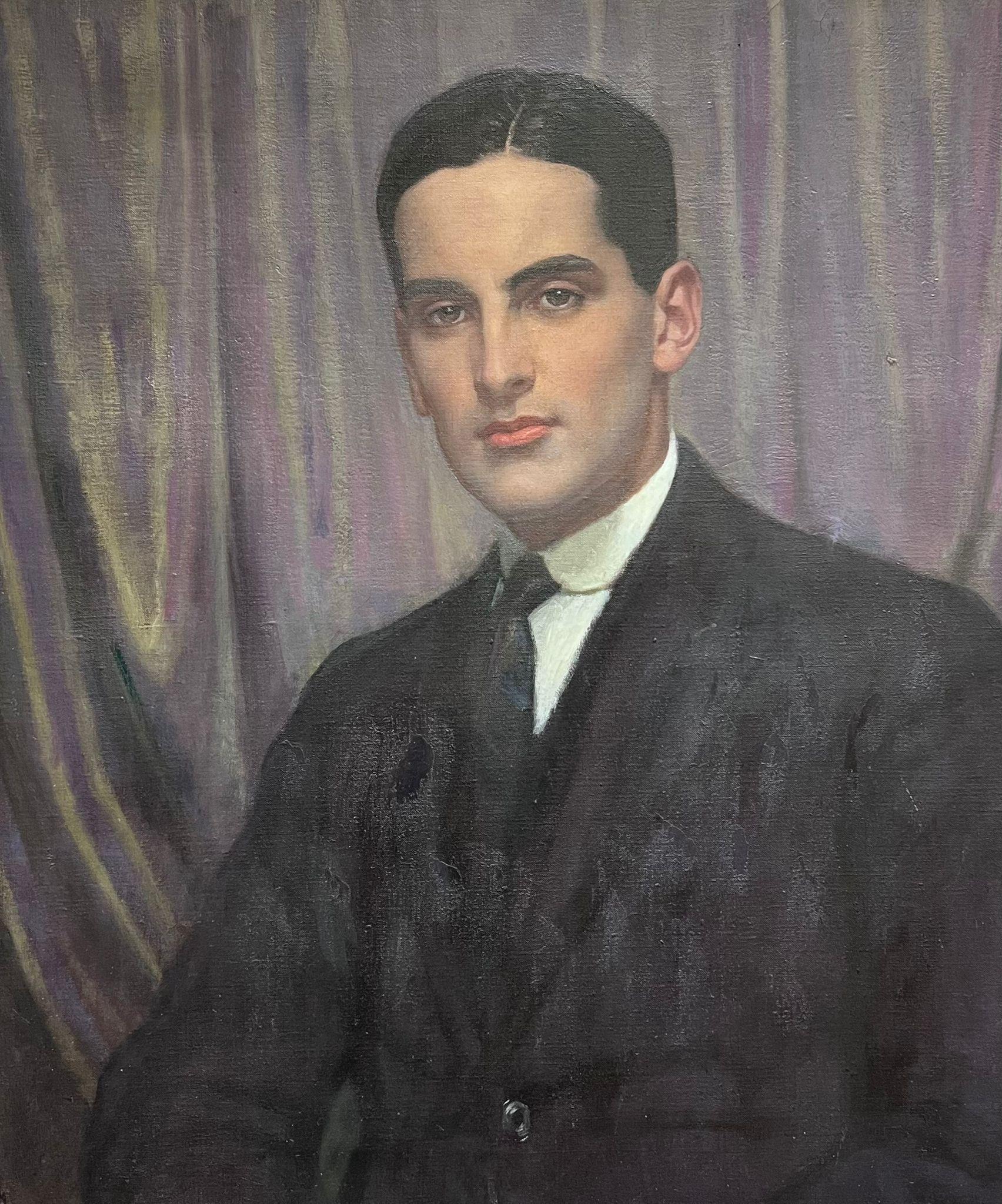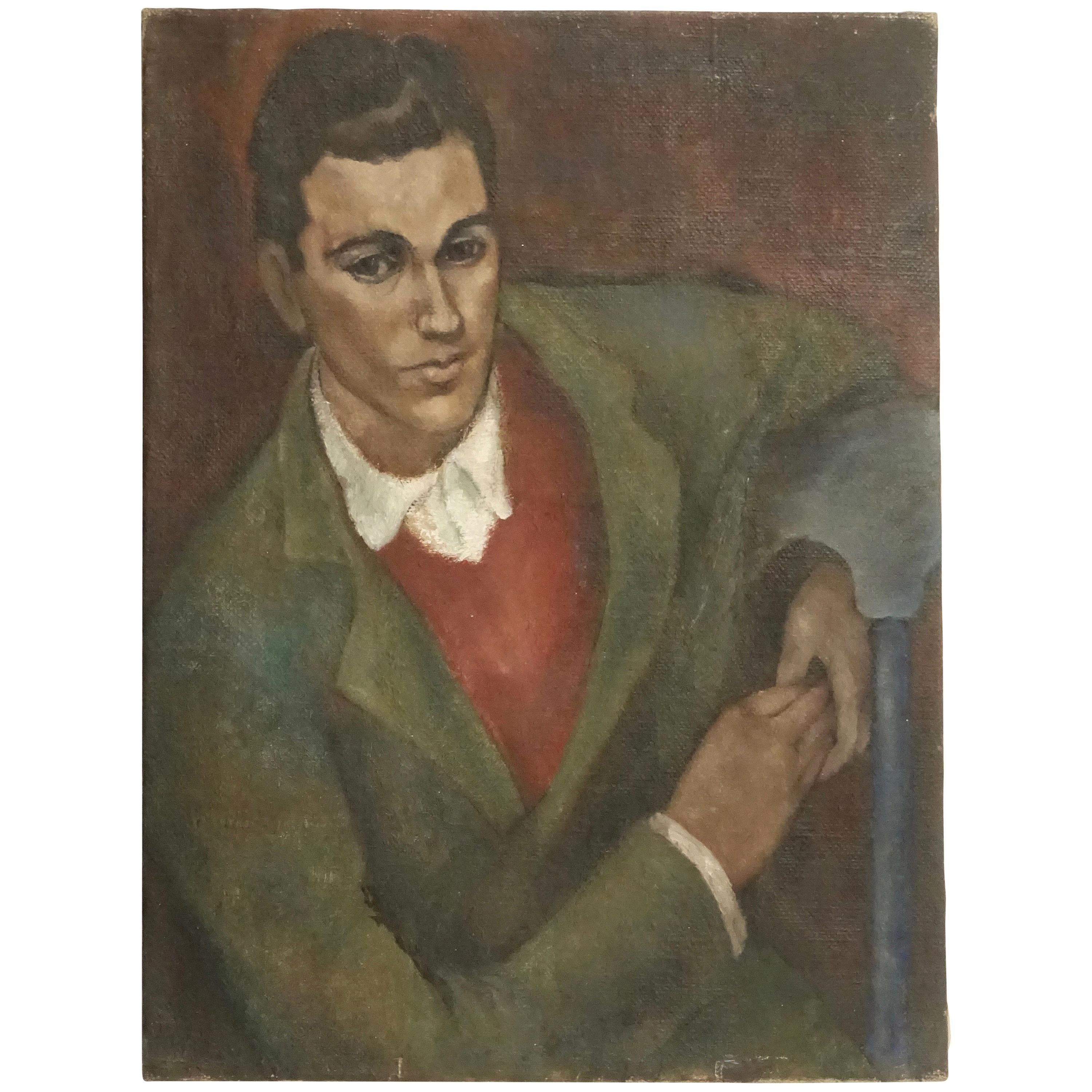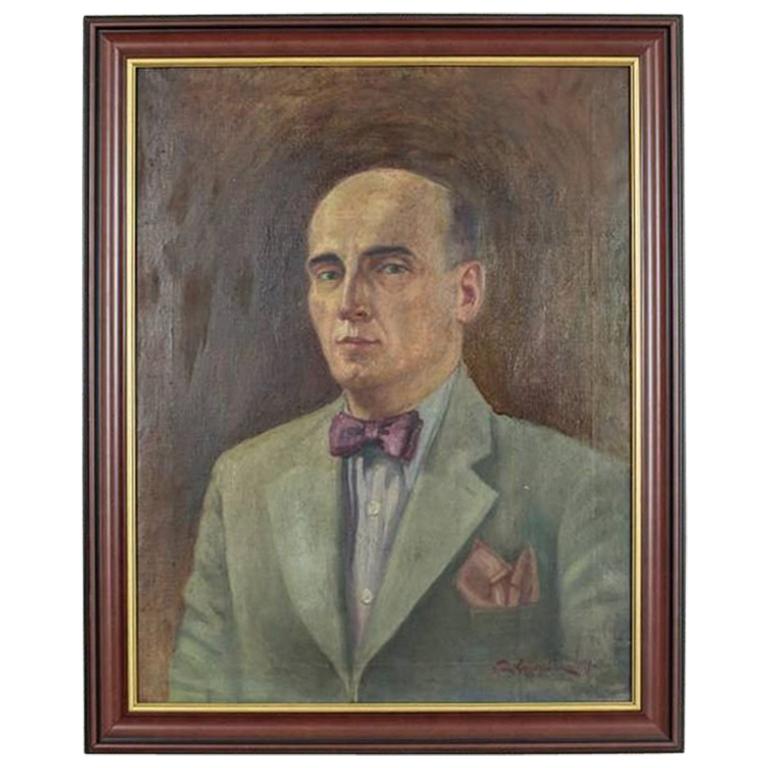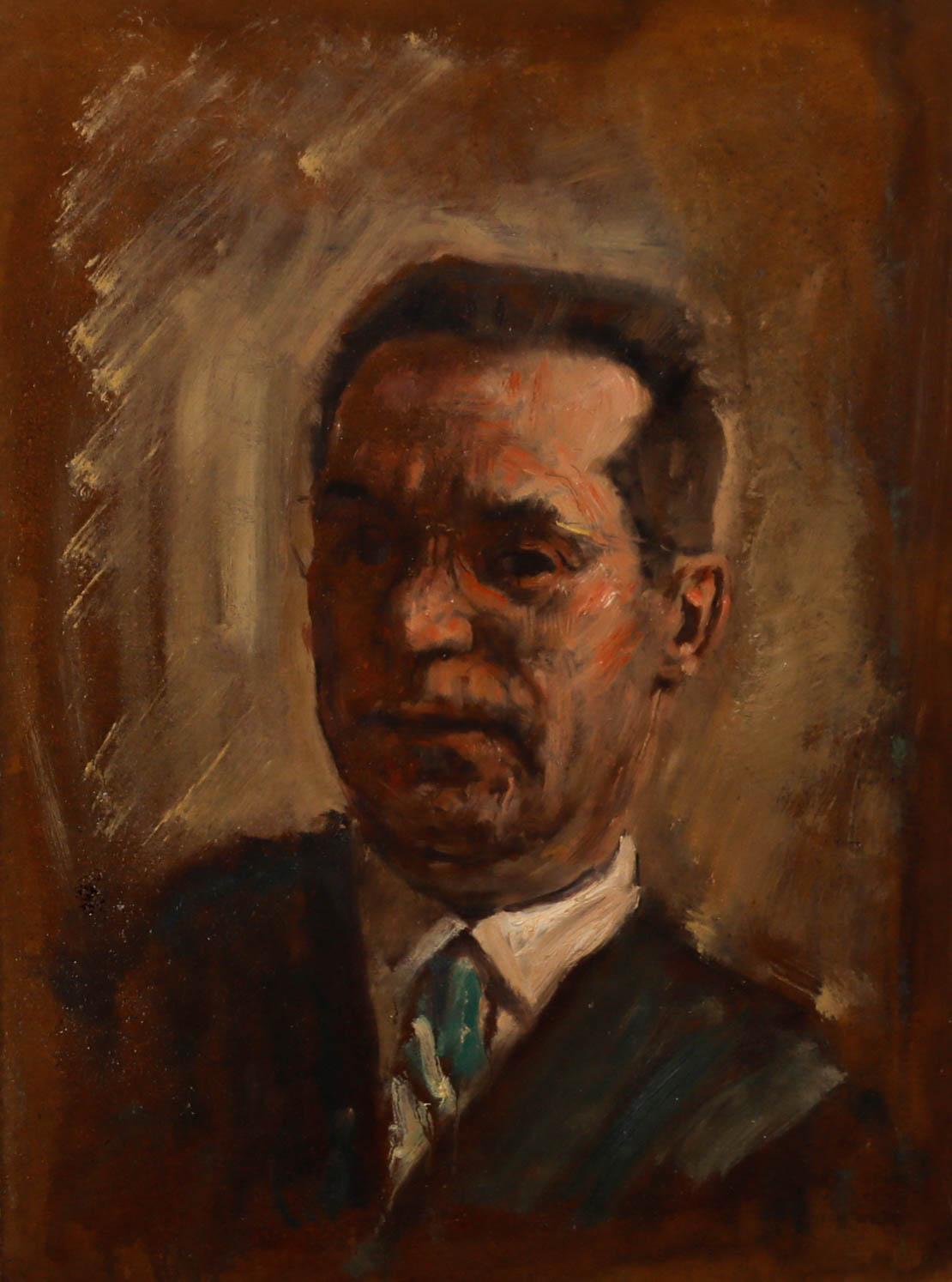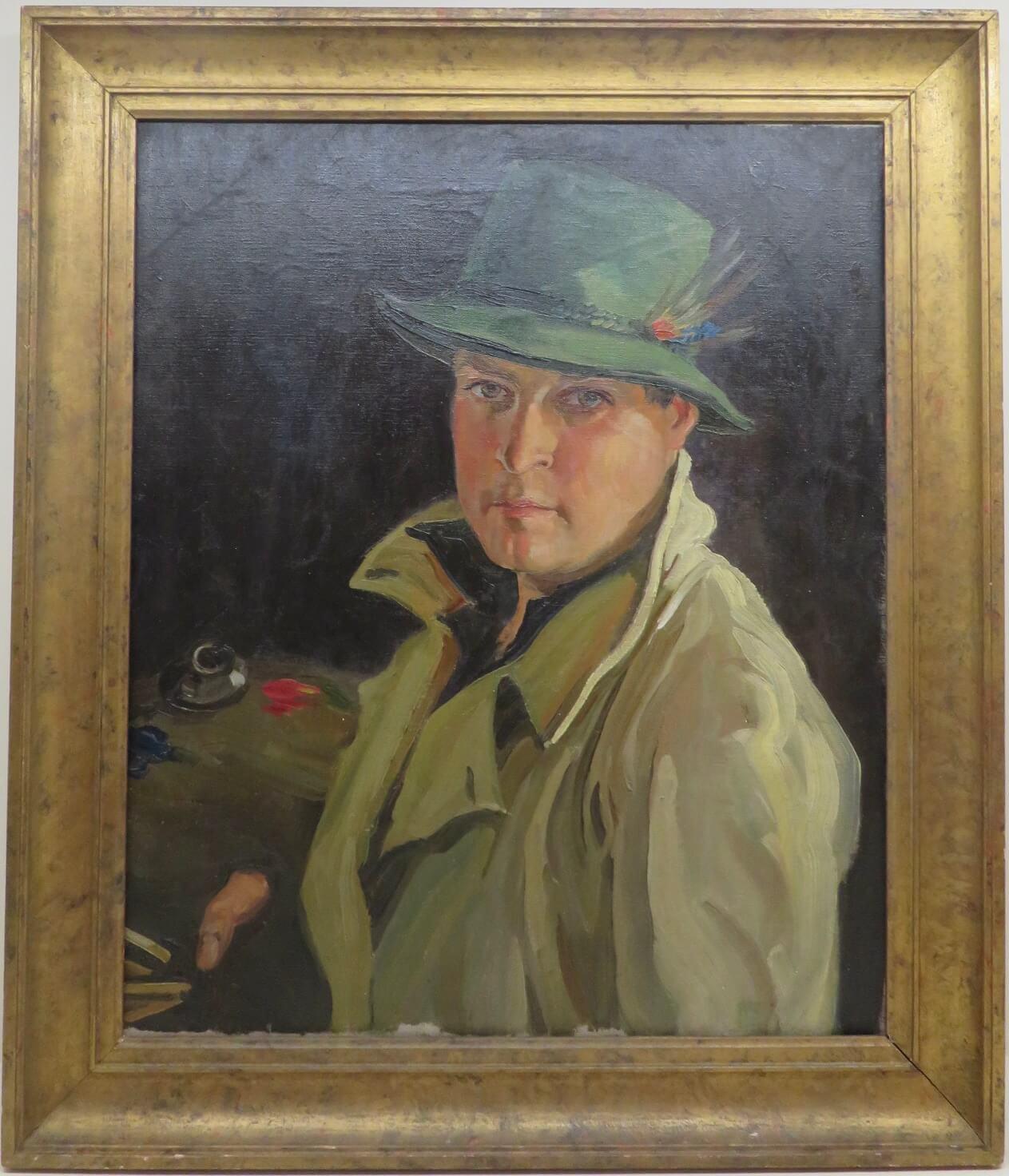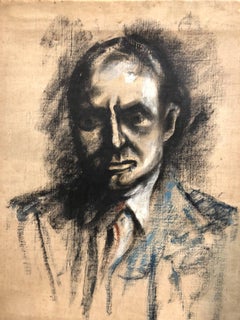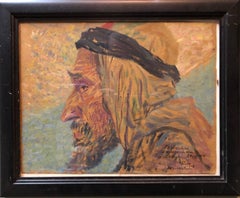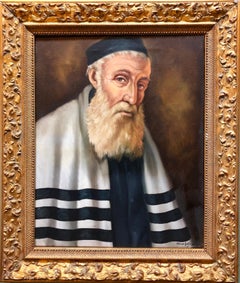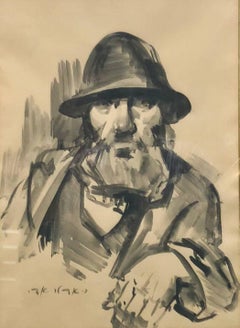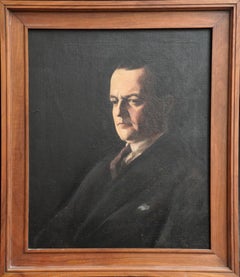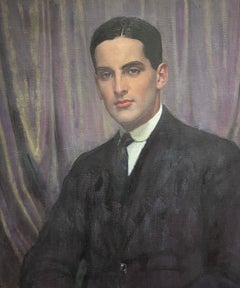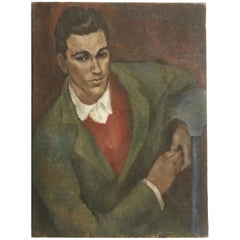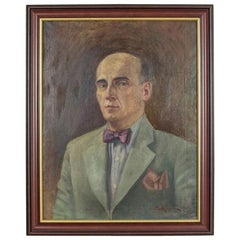Items Similar to Itzhak Holtz (Judaica Master) Oil Painting Portrait John Sloan Ashcan Artist WPA
Want more images or videos?
Request additional images or videos from the seller
1 of 14
Itshak HoltzItzhak Holtz (Judaica Master) Oil Painting Portrait John Sloan Ashcan Artist WPAc.1940s
c.1940s
$8,000
£6,070.22
€6,940.75
CA$11,173.83
A$12,423.78
CHF 6,487.01
MX$151,227.65
NOK 82,771.45
SEK 77,552.89
DKK 51,800.09
Shipping
Retrieving quote...The 1stDibs Promise:
Authenticity Guarantee,
Money-Back Guarantee,
24-Hour Cancellation
About the Item
Oil Painting Portrait of Ashcan Artist John Sloan. Signed I. Holtz.
The youngest of four children, Holtz was born and spent his early childhood in Skierniewice, Poland, a small town near Warsaw. His father was a hat maker and a furrier. In 1935, prior to World War II, when Holtz was ten years old, his family moved to Jerusalem, Israel, where they settled in the Geula neighborhood near Meah Shearim.
Itzhak Holtz's passion for art began early. When he was five years old, in Poland, his father first drew a picture of a horse and sled in the snow for him. The young Holtz looked at the drawing and studied it in wonderment. From that moment on, Holtz remembers, he constantly begged his father to draw for him. His enthusiasm for art grew and Holtz longed to study art. In 1945, he enrolled at the Bezalel Academy of Art and Design in Jerusalem, where he primarily studied lettering and poster work in a program geared toward commercial art Holtz became interested in painting, prompting him to move to New York City in 1950 to study at the Art Students League of New York under Robert Brackman and Harry Sternberg, and then at the National Academy of Design under Robert Philipp.
Holtz has stated that his artwork, which primarily but not exclusively, depict scenes of Jewish spirituality and tradition, is driven by his Orthodox Jewish beliefs: "You have to live that religious life to fully capture it on canvas." He has been classified in the school of genre painting, often depicting street scenes of ordinary people in everyday Jewish life in the back alleys and markets of Jerusalem neighborhoods such as Me'ah Shearim and Geula; and in New York neighborhoods and hamlets such as Monsey, Boro Park and Williamsburg. Along with street scenes, his work includes portraits of scribes, tailors, cobblers and fishmongers, and images such as shtetls, lighthouses, and wedding scenes. He started out painting mostly portraits in order to support his family, before expanding to include street scenes. His beloved subject matter is painting scenes of Jewish life, his childhood memories when his mother took him along shopping for the Sabbath to the markets of Meah Shearim, has left a deep impression on him and influenced many of his works. Holtz has experimented in the abstract, but then reverted to representational and figurative art to which he devoted himself exclusively. His Israeli street scenes are said to combine “an affectionate recollection of the past with the brilliance of the color of modern Israel.”
Holtz has stated that he struggled at first when he arrived to the USA because of financial reasons and because he only knew Polish, Yiddish and Hebrew, but then made good ties with his instructor who greatly influenced him Robert Philipp who helped him make friends and referred him to paint portraits.
Examples of Holtz's work throughout the years include: Yerusalem Wedding (2010), depicting a Chuppa in Jerusalem on early evening, oil on canvas; The Funeral(1966), depicting five stoic Hasidim carrying a body on a bier over to a gravesite, with the people behind them crying, in charcoal on paper and oil on canvas; Rejoicing (1974), an image of religious men dancing, in felt pen and marker on paper; and the oil painting Shamash Learning in Shul (2003), a portrait of a pious Jew studying the Talmud inside a claustrophobic synagogue scene.
Throughout the years Holtz has created hundreds of works in many art mediums, including, genre scenes, portraits, still lifes and landscape scenery, his works are sought after by art collectors worldwide, and he has been called the greatest living Jewish artist. It is said that no artist ever explored the Jewish subject like Holtz. Today some of his oil paintings have been commanding over $100,000.
Holtz creates his scenes after researching locations, and often uses locals as models. He paints slowly and with great care, but with a swift Impressionistic style. The people in his portraits and scenes are generally more cheerful and optimistic than standard portraits of Hassidic individuals. He paints oils and watercolors, and also does felt pen, pastel, marker, ink and charcoal drawings, as well as woodcuts. His oil paintings typically have a brown hue, while his work with felt pen is often in sepia tones, and on some of his works he used very bright colors, with a strong emphasis on the interplay of light and shadow. He is heavily influenced by the ancient staircases and alleyways of Jerusalem, with its modest religious population, which has made a strong impression on him in his youth, the streets of Tzfat, and the works of Rembrandt, Johannes Vermeer and Peter Bruegel, as well as Jewish artists Moritz Daniel Oppenheim, Tully Filmus, Leonid Pasternak and Isidor Kaufmann have had a strong influence on him. He has said that realism is the best way he can express himself.
John French Sloan (August 2, 1871 – September 7, 1951) was an American painter and etcher. He is considered to be one of the founders of the Ashcan school of American art. He was also a member of the group known as The Eight. He is best known for his urban genre scenes and ability to capture the essence of neighborhood life in New York City, often observed through his Chelsea studio window. Sloan has been called "the premier artist of the Ashcan School who painted the inexhaustible energy and life of New York City during the first decades of the twentieth century"and an "early twentieth-century realist painter who embraced the principles of Socialism and placed his artistic talents at the service of those beliefs." In the fall of 1884 he enrolled at the prestigious Central High School in Philadelphia, where his classmates included William Glackens and Albert Barnes. In 1892, he began working as an illustrator in the art department of The Philadelphia Inquirer. Later that same year, Sloan began taking evening classes at the Pennsylvania Academy of the Fine Arts under the guidance of the realist Thomas Anshutz.
In 1892, Sloan met Robert Henri, a talented painter and charismatic advocate of artistic independence who became his mentor and closest friend. Henri encouraged Sloan in his graphic work and eventually convinced him to turn to painting. They shared a common artistic outlook and in the coming years promoted a new form of realism, known as the "Ashcan school" of American art. In 1893, Sloan and Henri founded the short-lived Charcoal Club together, whose members would also include Glackens, George Luks, and Everett Shinn.
Sloan participated in the landmark 1908 exhibition at the Macbeth Galleries of a group that included four other artists from the Philadelphia Charcoal Club (Henri, Glackens, Luks and Shinn) as well as three artists who worked in a less realistic, more impressionistic style, Maurice Prendergast, Ernest Lawson, and Arthur B. Davies. The group was afterward collectively known as "The Eight." In 1922 he organized an exhibition of work by Native American artists at the Society of Independent Artists in New York. He also championed the work of Diego Rivera, whom he called "the one artist on this continent who is in the class of the old masters." The Society of Independent Artists, which Sloan had co-founded in 1916, gave Rivera and José Clemente Orozco their first showing in the United States in 1920.
In American Visions, the critic Robert Hughes praised Sloan's art for "an honest humaneness, a frank sympathy, a refusal to flatten its figures into stereotypes of class misery ... He saw his people as part of larger totality, the carnal and cozy body of the city itself." In American Painting from the Armory Show to the Depression, art historian Milton Brown called Sloan "the outstanding figure of the Ash Can School." To his friend, the painter John Butler Yeats, and to art critic Henry McBride, he was "an American Hogarth."
- Creator:Itshak Holtz
- Creation Year:c.1940s
- Dimensions:Height: 35 in (88.9 cm)Width: 29.25 in (74.3 cm)
- Medium:
- Movement & Style:
- Period:
- Condition:good, minor wear, please see photos. frame needs to be replaced.
- Gallery Location:Surfside, FL
- Reference Number:1stDibs: LU38213922092
About the Seller
4.9
Platinum Seller
Premium sellers with a 4.7+ rating and 24-hour response times
Established in 1995
1stDibs seller since 2014
1,784 sales on 1stDibs
Typical response time: <1 hour
- ShippingRetrieving quote...Shipping from: Surfside, FL
- Return Policy
Authenticity Guarantee
In the unlikely event there’s an issue with an item’s authenticity, contact us within 1 year for a full refund. DetailsMoney-Back Guarantee
If your item is not as described, is damaged in transit, or does not arrive, contact us within 7 days for a full refund. Details24-Hour Cancellation
You have a 24-hour grace period in which to reconsider your purchase, with no questions asked.Vetted Professional Sellers
Our world-class sellers must adhere to strict standards for service and quality, maintaining the integrity of our listings.Price-Match Guarantee
If you find that a seller listed the same item for a lower price elsewhere, we’ll match it.Trusted Global Delivery
Our best-in-class carrier network provides specialized shipping options worldwide, including custom delivery.More From This Seller
View AllBritish Modernist Portrait of Chaim Weizmann President of Israel Oil Painting
By Alfred Aaron Wolmark
Located in Surfside, FL
Alfred Aaron Wolmark (1877 – 1961) was a painter and decorative artist. He was a Post Impressionist and a pioneer of the New Movement in Art.
He was born Aaron Wolmark into a Jewish family in Warsaw, Poland who were amongst the many subsequently fleeing the pogroms of Eastern Europe. The family moved to Devon when he was six before moving to Spitalfields, East London, there along with many other Jewish immigrant émigré families. He became a British citizen in 1894.
He studied at the Royal Academy Schools and exhibited there from 1901-1936. (1895-8 (1st Silver Medallist for Drawing). There he took the name Alfred Wolmark, by which he is known.
Returning briefly to Poland in 1903, he painted works based his Jewish identity and faith, refraining from depicting the persecution and anti-Semitism his family witnessed on the continent and idealising the peaceful and contemplative elements of his religion. His first one-man exhibition was held at the Bruton Galleries in 1905.
In July 1911, after an artistic epiphany on honeymoon in Concarneau, Brittany, he became influenced by modern French painting, his colour palette and style became post impressionist, and Wolmark jettisoned his early methods in favour of the pioneering 'colourist' path that he followed for the next two decades of his working life. He was a British fauvist and pitched his tonal divisions to a higher key than any of his contemporaries. Wolmark kept to traditional genre, and transformed his subjects through the use of flattened forms, built up with a heavy impasto. His daring use of bright colour on some paintings such as "An Arrangement: Group of Nudes" demonstrate a skillset akin to Andy Warhol and earned him the title of ‘The Colour King’. the early colourist, Alfred Wolmark, the so-called father of the ‘Whitechapel Boys’. This group includes painters David Bomberg, Mark Gertler and Jacob Kramer, as well as (by association) the sculptor Jacob Epstein, First World War poet-painter, Isaac Rosenberg, and the only ‘Whitechapel Girl’ Clare Winsten...
Category
Early 20th Century Modern Portrait Paintings
Materials
Canvas, Oil
Rare Oil Painting Arab Man Bezalel School Jerusalem 1913, Judaica
By Isaac Lichtenstein 1
Located in Surfside, FL
Extremely rare work of art from the early Bezalel School of Boris Schatz in Ottoman Palestine. it depicts an Orientalist Arab Sheik in traditional Headwear.
YITSKHOK LIKHTENSHTEYN ...
Category
Early 20th Century Post-Impressionist Figurative Paintings
Materials
Paper, Oil Pastel, Oil
Rare Hungarian Jewish Rabbi Judaica Oil Painting Portrait
By Lajos Polczer
Located in Surfside, FL
Rare Pre World War II (Pre Holocaust) Judaica Art. European Judaic art from this period is exceedingly rare.
Polczer was an Hungarian artist, his foundations of painting were taught by a painter Bertalan Karlovszky. His works were exhibited in the National Salon and the Art Hall from 1928. His works are held by the Hungarian National Gallery. In his later years he worked in the United States, he was working in New Orleans, Louisiana in the late 1960s. Known for his Jewish genre scenes, Chess scenes and other early 20th Century salon style nude paintings. In the tradition of Moritz Oppenheim...
Category
Mid-20th Century Post-Impressionist Figurative Paintings
Materials
Oil
Israeli Judaica Rabbi Expressionist Gouachel Painting
By Adolf Adler
Located in Surfside, FL
size includes frame
Adolf Adler 1917 - 1996
Adolf Adi Adler was born in Romania in 1917. Attended the Art College of Kluj Romania in 1950. (in Satu Mare, original home city of the Satmar Hasidic group). In 1963, Adler was chief among a group of well known artists who immigrated to Israel. He was awarded the Nordau prize in 1978. He works have been auctioned at Sloan's Auction House in Maryland and Karrenbauer Auction House in Germany and today are represented in the Yad Vashem Holocaust Museum in Jerusalem. In 1984, a retrospective of his work was held in Rishon Le Zion. He died in 1996.
Awards and Prizes
1993 Mordecai Ish-Shalom Prize, Artists House...
Category
Mid-20th Century Expressionist Figurative Paintings
Materials
Paper, Gouache
Oil Painting "The Rabbi" Sensitive Judaica Portrait by Italian American master
By Roberto Lupetti
Located in Surfside, FL
Born in Milan, Italy Lupetti studied at the Royal Academy in Rome where he received classical training and was apprenticed to the school of restoration at the Vatican. At the age of fourteen he was accepted to attend Brera Liceo Artistico, one of the most prestigious art academies in Italy, graduating at age eighteen and then went on to win honors from the Royal Academy of Fine Arts in Rome eventually receiving the degree of Professor of Fine Arts. In Milan, he helped restore the famed La Scala Opera House, and in Rome he earned the right to help in the restoration of the Masters' Works in the Vatican's Sistine Chapel. Following service in WWII, Roberto came to America sponsored by the famous conductor Arturo Toscanini. A painting he did of the maestro was purchased by the San Francisco Art Commission. He moved to San Francisco where he taught at the Art Institute.
As well as decorating churches throughout the U.S., he also painted portraits of such celebrities as Ingrid Bergman, Barbara Stanwyck, and General George Marshall. Roberto Lupetti earned five degrees at the Royal Academy of Fine Arts. Roberto was married to fellow artist Lynn Lupetti...
Category
20th Century Realist Portrait Paintings
Materials
Canvas, Oil
Judaica Oil Painting 1945 Palestine Old Jewish Man Polish Israeli Artist
By Ozer Shabat
Located in Surfside, FL
Ozer Shabat 1978-1901
Ozer Shabbat was an Israeli painter, a resident of Haifa. Belonged to the Palestine Expressionist group of the late 1920s and early 1930s.
Shabbat was born in Wolbrom, Poland. At the end of the First World War he went to Holland for agricultural training in the framework of the HeChalutz movement, prior to his immigration to Palestine. In 1920 he immigrated to Eretz Israel and joined the Hulda group. Later he joined the Merhavia group and there he began painting. Because of his desire to study drawing, he left the group and moved to Jerusalem. In 1921, he wrote articles in the newspaper "HaSadeh" on the subject of agriculture and Dutch cheese.
Ozer Shabath won the first prize in a competition for the design of the Dutch Consulate's Garden in Jerusalem, enabling him to travel to Paris in 1923 to study painting. Until 1925 he studied painting at the Grande Chaumiere Academy in Paris. This year he returned to Eretz Israel and settled in Haifa, where he lived until his death.
In 1928 he participated for the first time in an exhibition of Eretz Israel artists at the Tower of David. Since then he has participated in all the general exhibitions of Israeli artists. In 1934, together with painters Menachem Shemi, Avraham Mohar, Zvi Meirovitch and others, he founded the Haifa Artists' Group. In 1935-36 he toured Europe and visited Italy, France and England. During his visit, he maintained contacts with artists from the Jewish school of Paris.
He has exhibited in several solo exhibitions, represented Israel in exhibitions in Europe and participated in international exhibitions in New York, Johannesburg and Zurich. In 1958 he represented Israel in the Venice Biennale. In 1960, Shabat, together with Elchanan Halpern he represented the Israeli Painters Association at the International Congress of Plastic Arts held in Vienna, Austria . In the 40s and 50s he focused on landscape pictures. However, despite the focus on the Israeli landscape, the approach is universal in the framework of the post-Impressionist painting school. In the 1960s, his approach changed and he turned more to abstraction. The abstract direction gradually evolved. The point of departure of the abstract approach is the architectural landscape, but this view loses its real character and becomes only imaginary: the buildings lose their real character and turn into exclusive geometric areas that are usually set against a dark background. Over time, architecture captured the lion's share of his paintings. Cities like Safed, Jaffa and Jerusalem are the subject of many pictures.
He taught painting and art at the schools of the kibbutzim in Ramat Yochanan and Kfar Yehoshua, in high schools in Haifa and in the IDF and Gordon seminars.
His paintings were purchased and are in the permanent collection of the Bezalel National Museum (now the Israel Museum), Haifa Museum of Art, Haifa Maritime Museum, Acre Municipal Museum.
Select Solo exhibitions
1936 - Nadler Gallery, Haifa.
1943 - The Tel Aviv Museum of Art.
1952 - Artists House, Haifa.
1953 - Bezalel House, Jerusalem.
1955 - Gallery in Geneva, Switzerland.
1955 - The Writers' Club, Haifa.
1959 - Artists House, Haifa.
1960 - Museum of Modern Art, Haifa.
1962 - Museum of Modern Art, Haifa.
1963 - Gallery 220, Tel Aviv.
1968 - The Municipal Museum of Beit Emanuel, Ramat Gan.
1979 - Memorial exhibition marking the first anniversary...
Category
1940s Post-Impressionist Figurative Paintings
Materials
Canvas, Oil
You May Also Like
Portrait of George Hopkinson - British 20's male oil painting Russian Jewish art
By Jacob Kramer
Located in London, GB
This superb portrait oil painting is by noted Russian Jewish artist Jacob Kramer. The sitter is a friend of the artist, George Hopkinson, proud Yorkshireman and textile businessman w...
Category
1920s Realist Portrait Paintings
Materials
Oil
Large 1950's Portrait of Dashing Gentleman Oil Painting on Canvas
Located in Cirencester, Gloucestershire
Portrait of a Gentleman
European artist, mid 20th century
oil on canvas, framed
framed: 35.5 x 30.5 inches
canvas: 30 x 25 inches
provenance: private collection, England
condition: o...
Category
Mid-20th Century Impressionist Figurative Paintings
Materials
Oil
WPA Style Portrait Painting of a Gentleman, American, 1930s-1940s
Located in San Francisco, CA
Portrait painting of Walter Levin, oil on canvas, unframed. Signed Haughton College Bickerton in upper right corner, and having the original gallery label on the back. California Bay...
Category
Mid-20th Century American Paintings
Materials
Canvas
Portrait of a Man, Oil on Canvas, Signed by the Author, circa 1937
Located in Opole, PL
An oil painting on canvas with the half-length portrayal of a man.
The painting is signed by the pre-war painter of Lviv, Adam Krotochwila.
This fine piece of art is in very good...
Category
Vintage 1930s Polish Paintings
Materials
Canvas
$1,429 Sale Price
20% Off
George Weissbort (1928-2013) - 20th Century Oil, Portrait of a Man in a Suit
By George Weissbort
Located in Corsham, GB
Unsigned. Provenance: Studio Sale. On board.
Category
20th Century Portrait Paintings
Materials
Oil
FRANCIS WYNNE THOMAS (1907-1989) Mid 20th Century oil painting ARTIST PORTRAIT
Located in Cirencester, GB
ARTIST: Attributed to Francis Wynne Thomas (1907-1989) British
TITLE: "Portrait Of An Artist"
SIGNED: appears unsigned - later inscribed verso
MEDIUM: oil on canvas
SIZE: 73cm x 6...
Category
Mid-20th Century Post-Impressionist Figurative Paintings
Materials
Oil
More Ways To Browse
Jewish Portrait
Judaica Artist
Jew Painting
Men Dancing
Vintage 1940s Paint Colors
Portrait Of Maurice
Modern Judaica Painting
New Order Poster
Synagogue Painting
1940s Vintage Ties
Maurice Henry
Vintage Philadelphia Poster
Jewish Wedding Painting
Polish War Poster
Rembrandt Mother
Vintage Lawson
Vintage Dancer Hats
1945 New York Graphic Society

